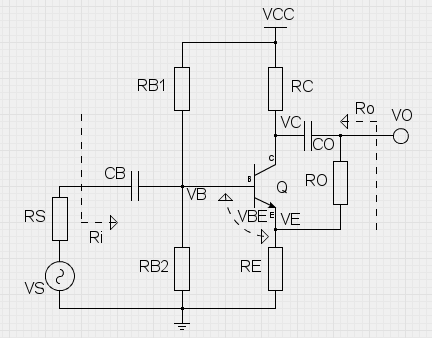| OVERVIEW
This is a simple design tool for calculating bias resistor values,
small-signal gain and input/output resistances of a CE amp with resistor parallel with the BJT
small-signal internal output resistance ro.
The base bias resistor values are calculated automatically (using 5% tolerance resistances),
but custom values can be given and those will not be overwritten.
After iterating any resistance value, always press 'Calculate results'
button to update the results.
The small-signal values are evaluated in the mid-band, CB and CO short-circuited.
The small-signal gain is evaluated as VO/VS, and the input/output
resistances are evaluated as shown in the pic. |
 |
| Select the operating voltage VCC. Typically 9 volts is the way to go. |
VCC: |
volts |
RESULTS
DC Bias voltages:
VC : volts
VE : volts
VB : volts
AC Voltage Gain factor:
Av : const
dB
AC Input resistance:
Ri : ohms
AC Output resistance:
Ro : ohms
|
| Select the BJT you want to use, from its datasheet
lookup the current gain factor and place it here as a parameter. |
hFE: |
const |
| For convenience, you can change the base-emitter voltage,
which is set to 0.65 V by default.
Typical VBE is 0.55 - 0.75 V. |
VBE: |
volts |
| Choose the collector bias voltage to aim for.
Typically the collector bias voltage is half of the operating voltage VCC. |
VC: |
volts |
| The collector resistor RC should be chosen to limit collector current to the suitable level.
RC defines also the output impedance. |
RC: |
ohms |
| RO is parallel to transistor internal resistance ro.
Adjust this value to see the effects on the gain and terminal impedances |
RO: |
ohms |
| Choose the emitter resistor RE for bias stability.
It is good to have VE close to 0.6 volts.
The value of RE affects the base bias resistor values and input impedance. |
RE: |
ohms |
| A multiplier for base resistor values, which are obtained in the next step.
Too much resistance at the base affects the stability of biasing.
Use values between 4 - 16. |
Bx: |
const |
Use 'Calculate values' button to evaluate exact values for base resistors.
Then use the arrow buttons to round up or down to nearest standard value, or leave as is.
|
RB1:
RB2:
|
ohms
ohms
|
| Also, the internal resistance of the signal source should be given.
For ideal source this value is small,
but for guitar output this is a few kilohms. |
RS: |
ohms |
|